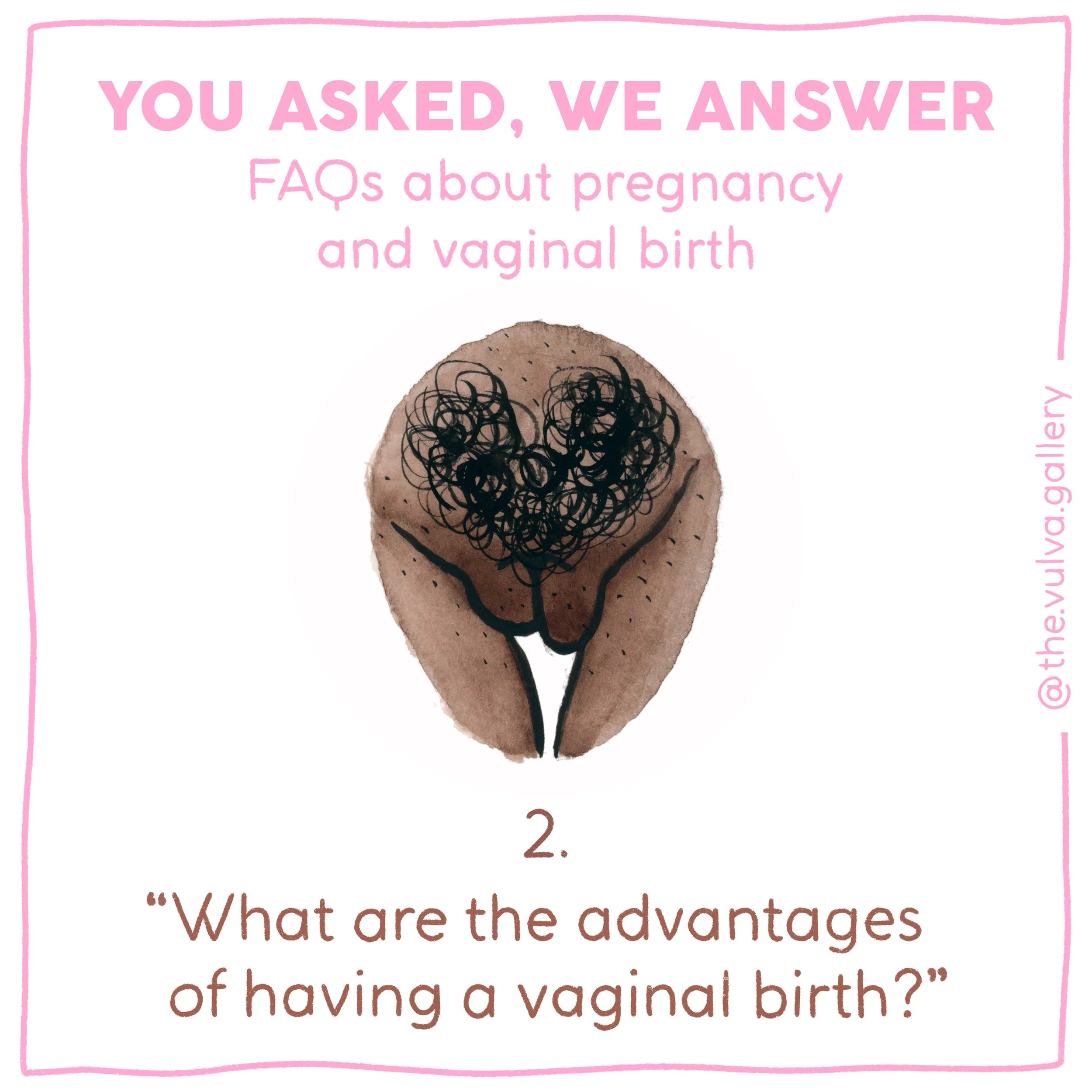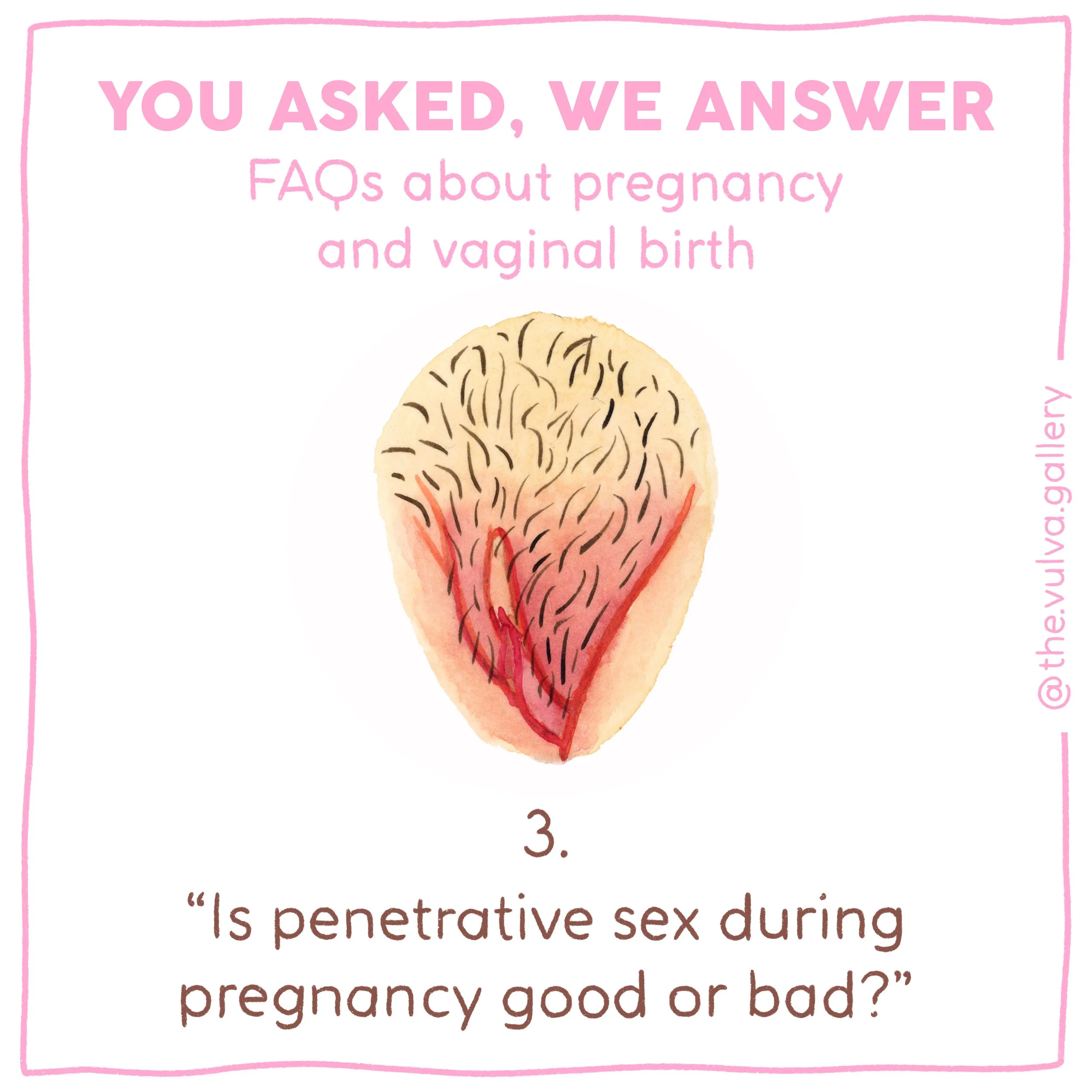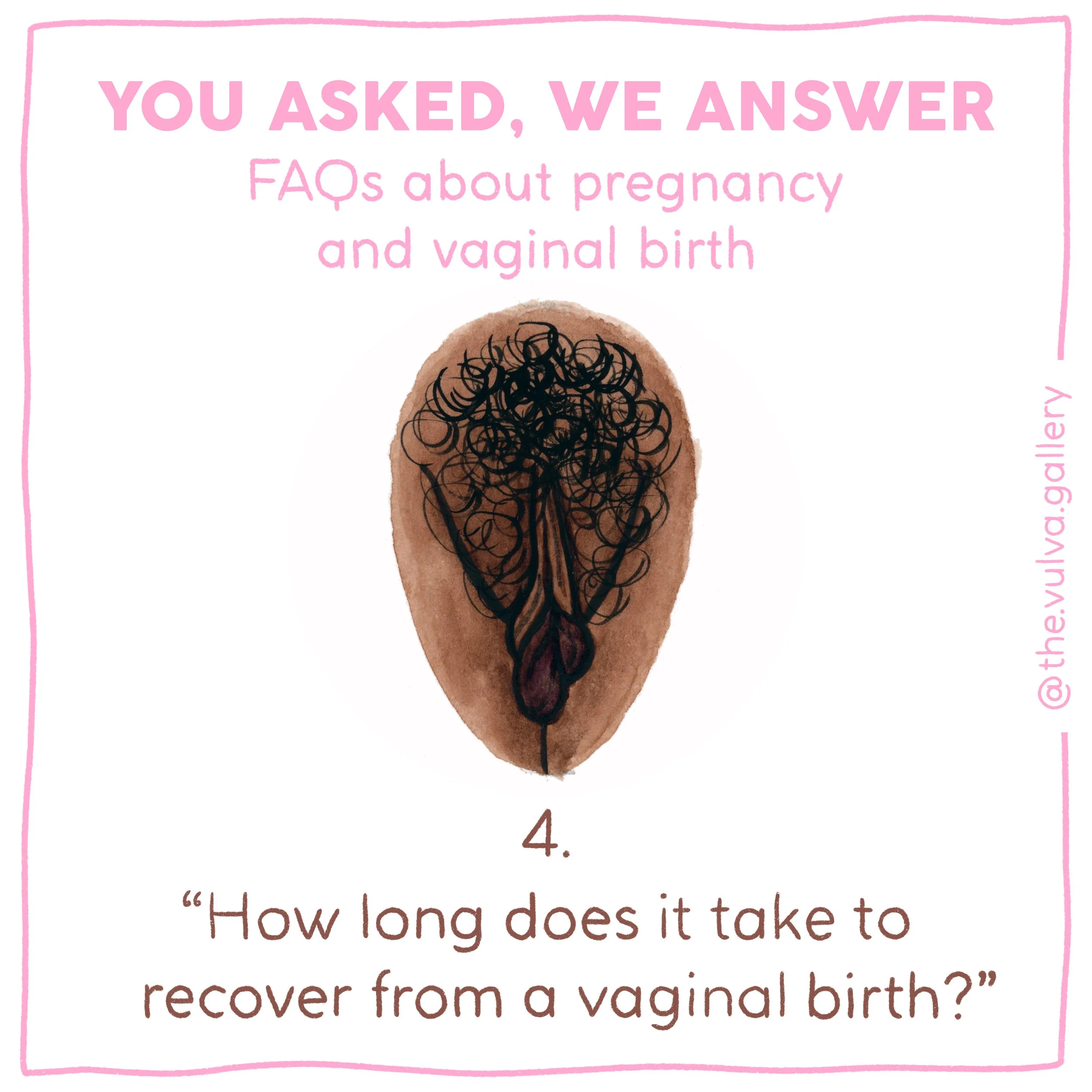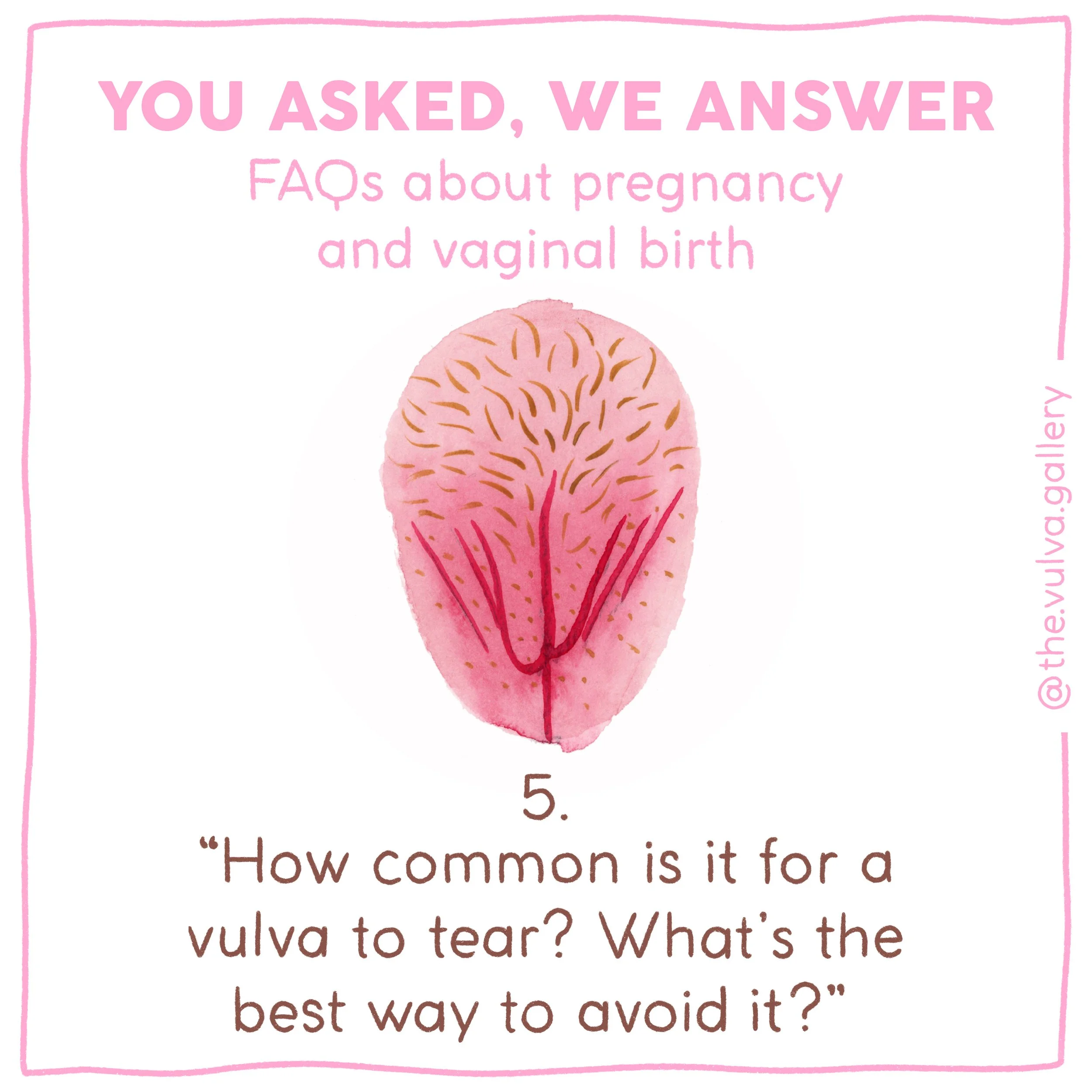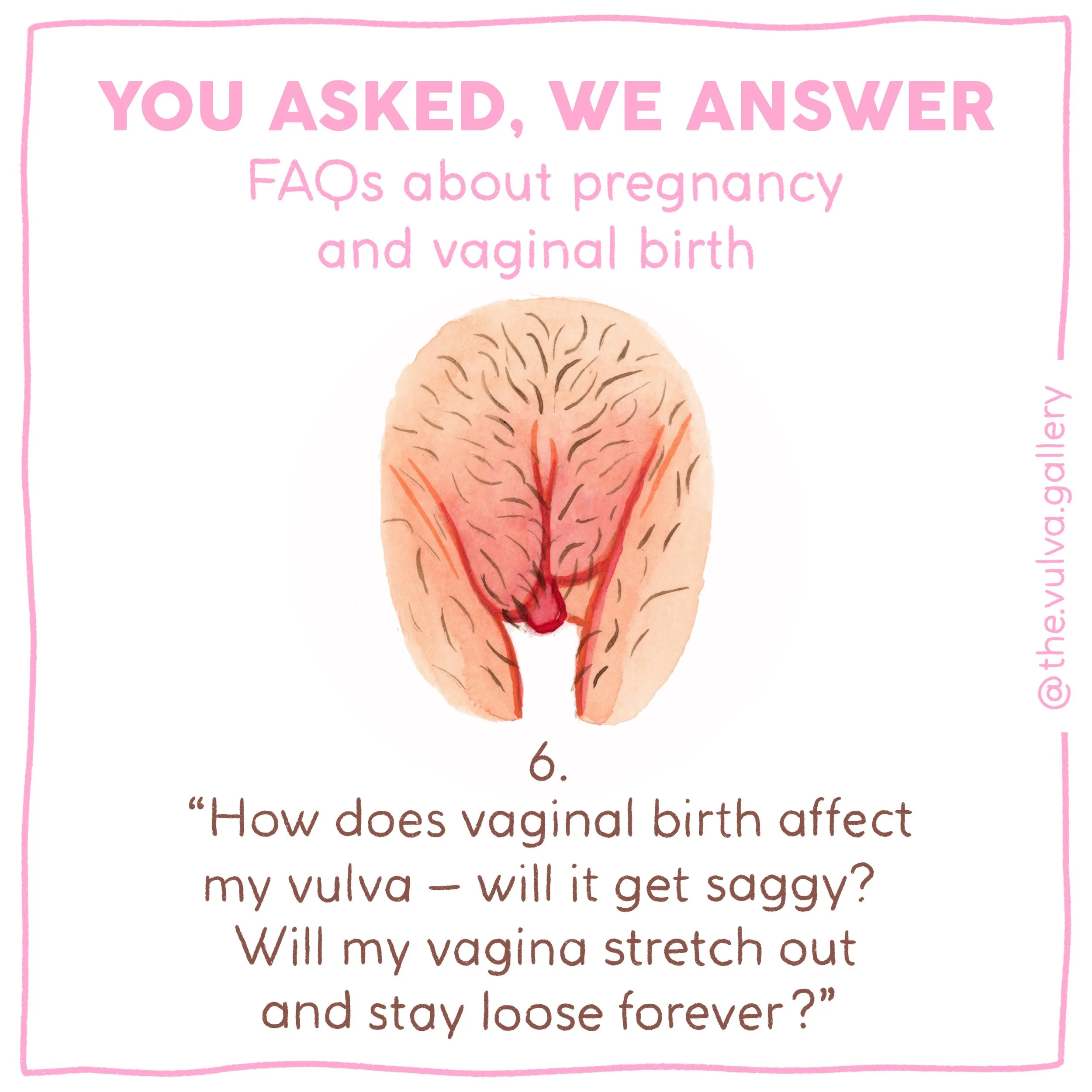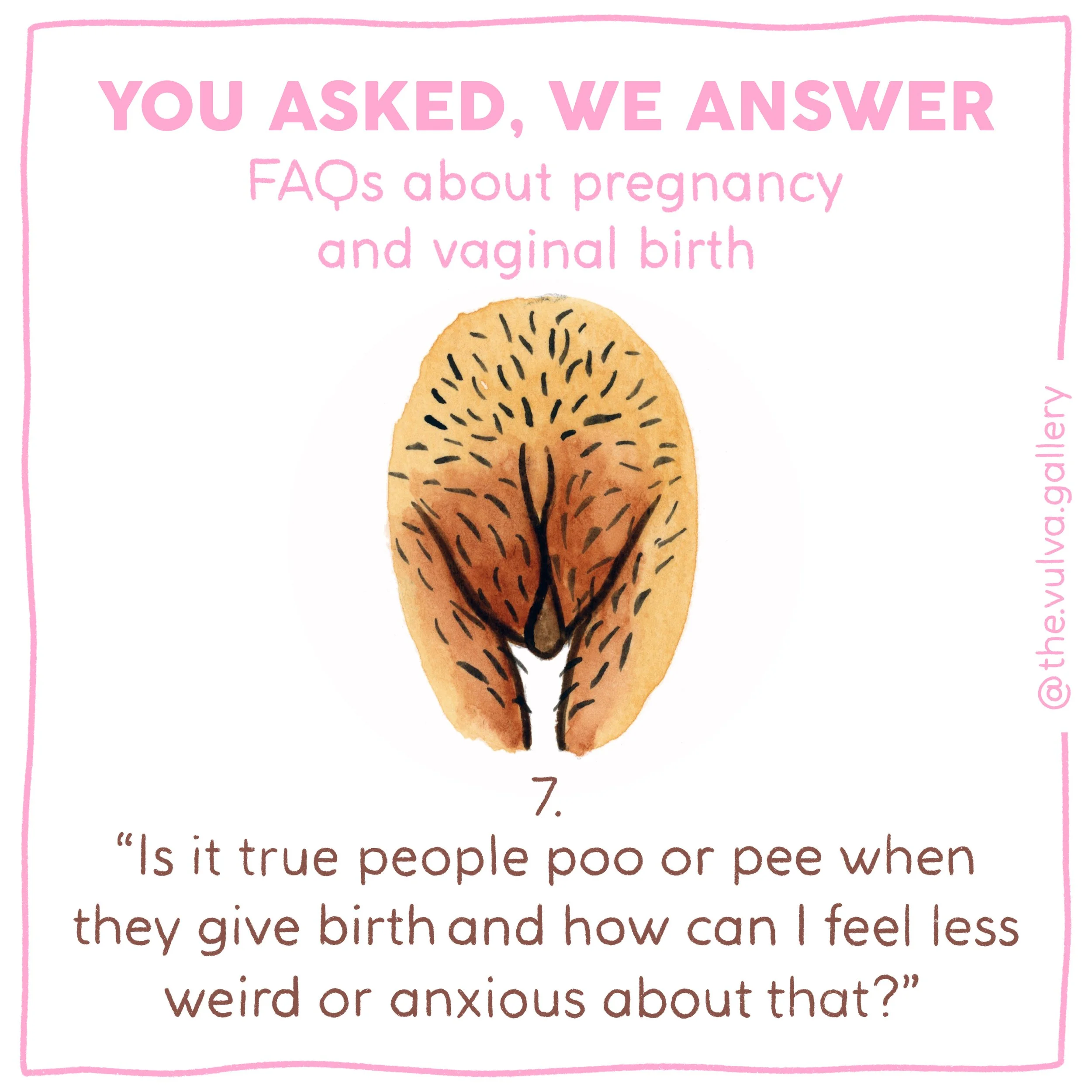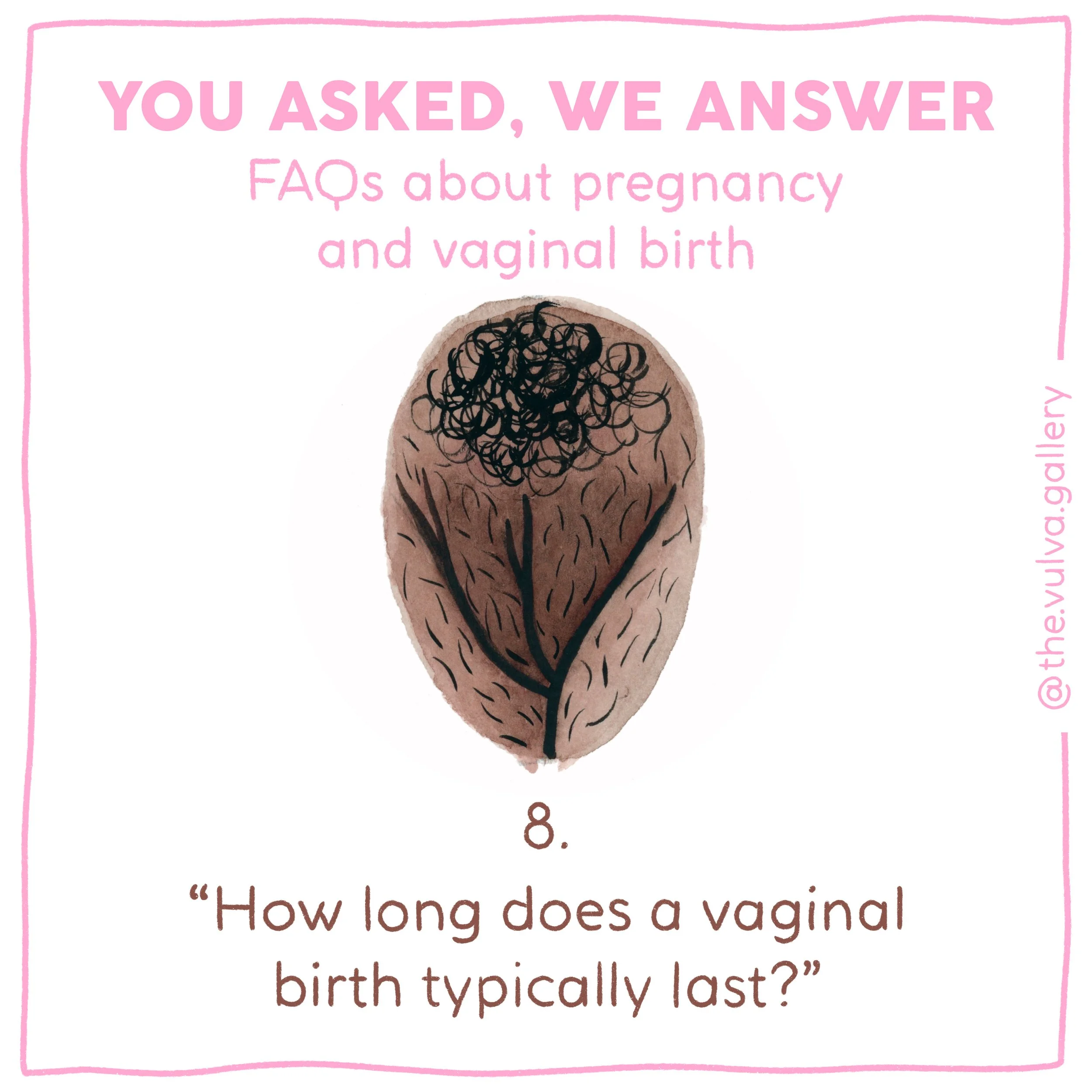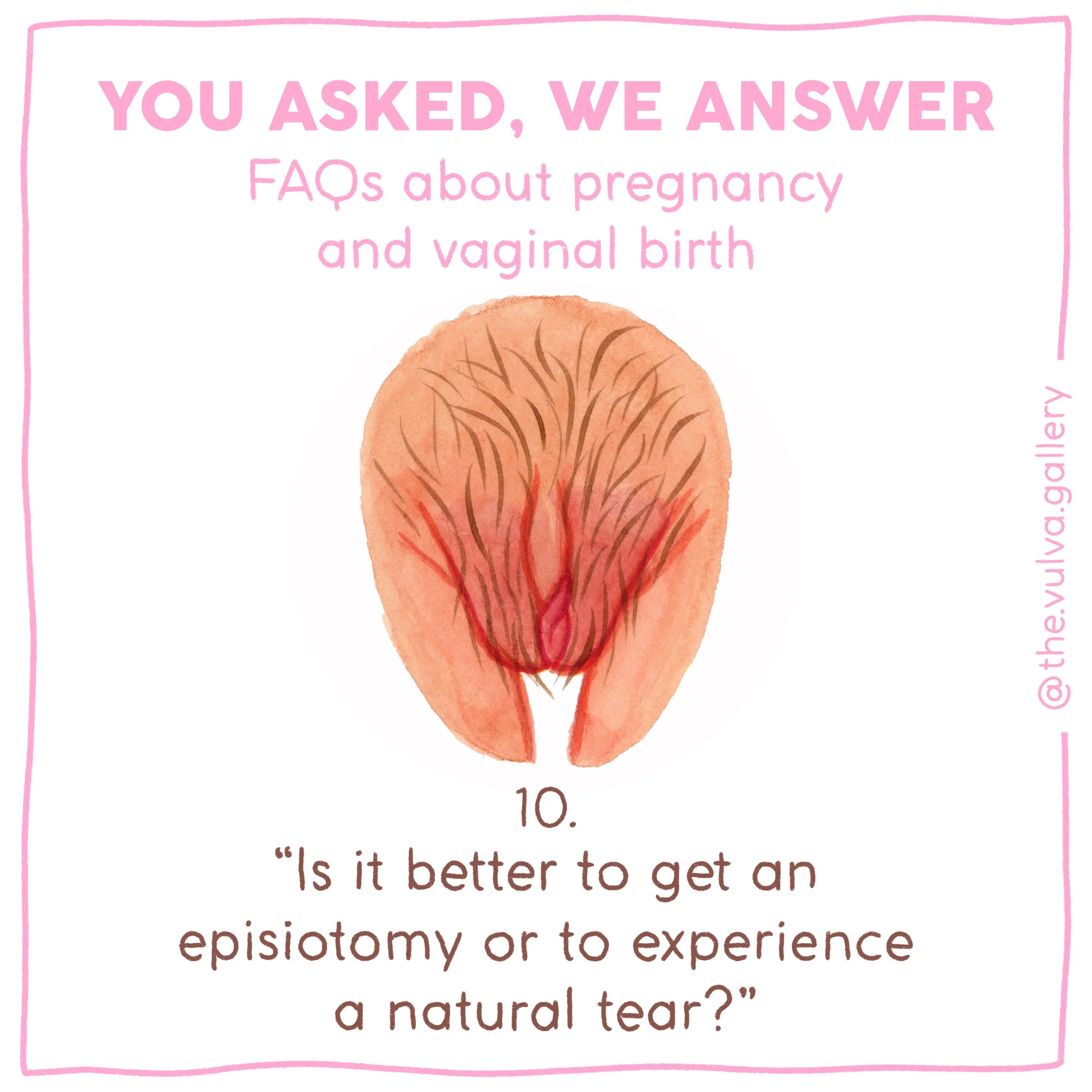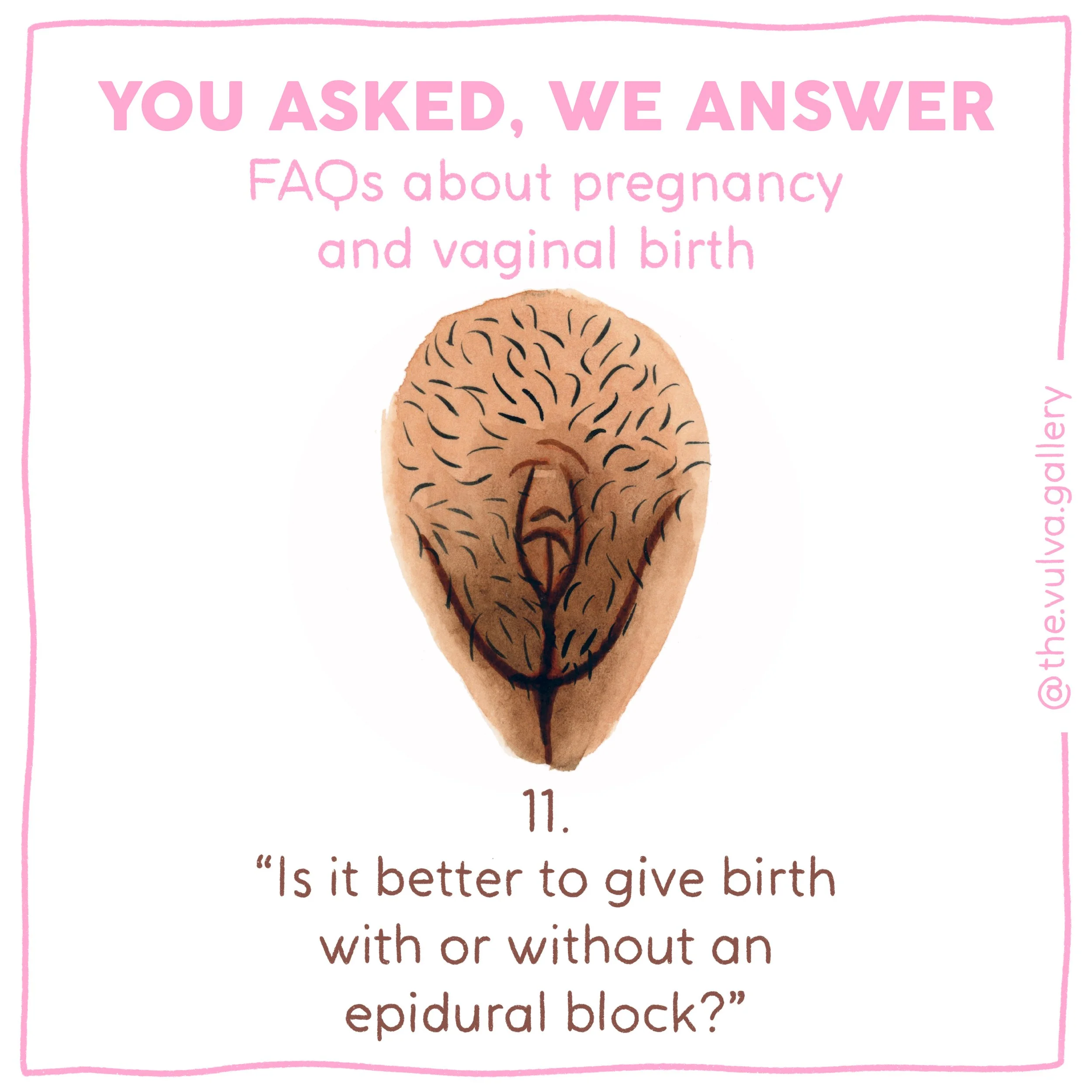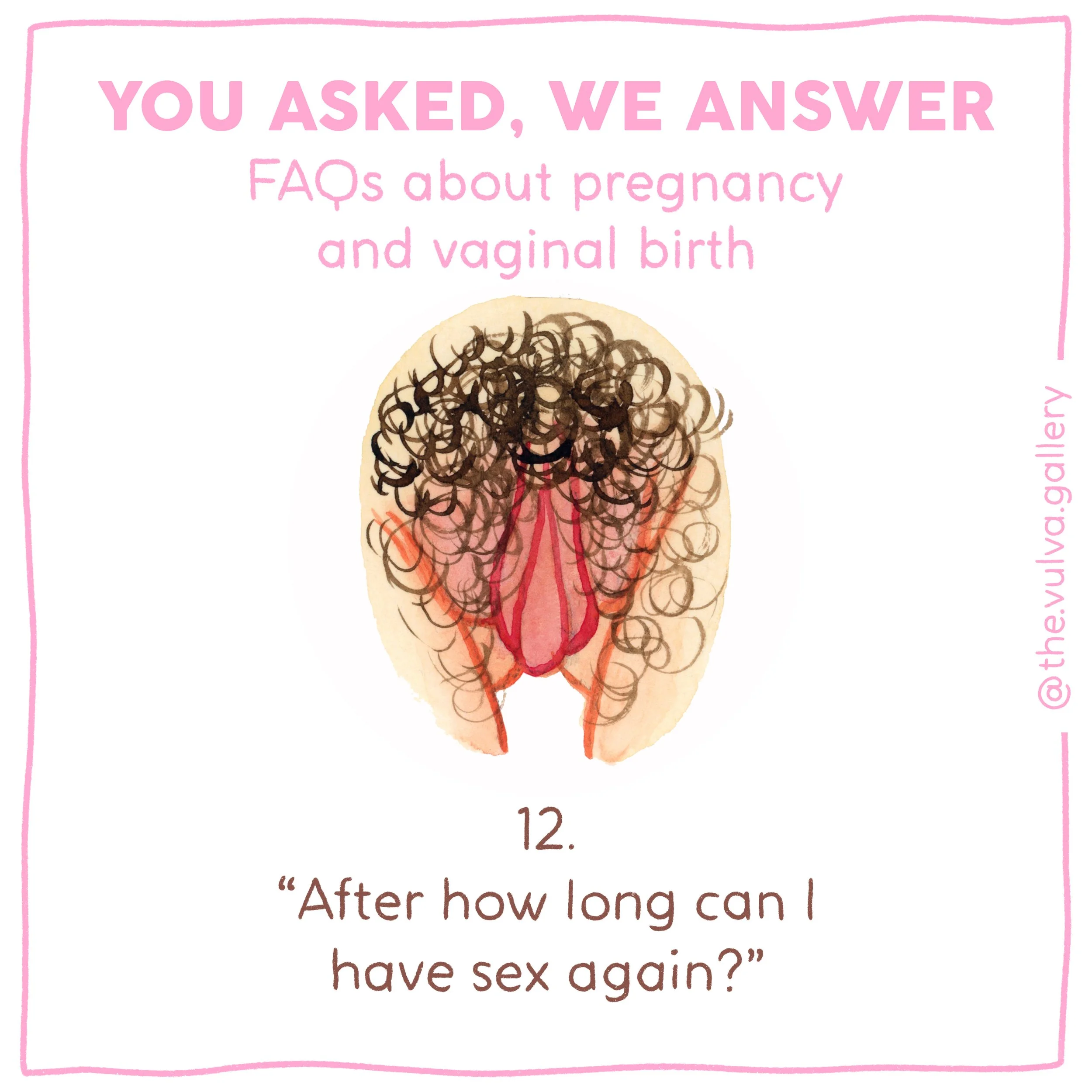Pregnancy & Vaginal Birth
In 2024 I’ve taken the step to a new approach: I want to shine light onto a different theme every other month. This gives me the opportunity to dive more deeply into all kinds of topics. I’ll also invite community members and experts to share your experiences and knowledge on the different topics.
We kicked of with January’s theme: Pregnancy & Vaginal Birth, and how these can affect our vulva and vagina. Below you’ll find the collection of anatomical illustrations I’ve created (these are now available as an Education Set), plus a section with Community FAQs that were answered by medical health professionals.
Education Set
The set contains 15 square prints, each with a different watercolour image and information related to vulvar anatomy + a digital set.
FAQs about Pregnancy and Vaginal Birth
In November I asked the community: “What would you like to know about pregnancy and vaginal birth?” I’ve collected the questions and shared them with medical health providers. Below you can find a selection of their answers
“How does pregnancy affect my vulva and vagina?”
Debs Neiger (she/her) / @debsagos, Independent midwife, Independent Practice, UK: “Pregnancy affects your vagina and vulva in surprising and interesting ways. Blood flow increases, and for many people, vulval and/or vaginal changes can be one of the first signs of pregnancy. Your vulva may feel more puffy and swollen, the colour may change to a deeper pink/purple. Also as a bonus, sensations may change subtly or in quite dramatic ways: sensitivity might be increased and s/x drive may be ramped up. Generally, people feel a lot more ‘juicy’ in pregnancy.
However, that increase in sensitivity can also backfire somewhat, cause itchiness and a generally tender vulva. You may find swollen veins too - and yes, you can get varicose veins on your vulva which are generally benign but can be bothersome and uncomfortable.
You may find that discharge from your vagina is significantly increased too. Normal pregnancy discharge is clear to white in colour and can be fairly copious. Other colours of vaginal discharge such as grey, green or pink (and certainly bleeding too), or odd smelling vaginal discharge is worth getting checked out by your care provider, as you are a little more prone to thrush or vaginal infections (such as bacterial vaginosis etc) during pregnancy.”
“What are the advantages of having a vaginal birth?”
Dr. Kelly Sadauckas (she/her) / @therealpelvicfloored, Doctor of Physical Therapy, OCS, WCS, Pelvic Health Physio, Board Certified in Pelvic Health & Orthopedics, Private Practice, USA: “First off, all birth is birth. If you have had a cesarean delivery, it was for a very specific reason – and you didn’t do anything wrong that resulted in that delivery method, so there should be NO birth shaming to you by anyone. That being said, there are some advantages to having a vaginal birth for both mama/birthing parent and baby.
Benefits for mama/birthing parent include a lower risk of requiring a blood transfusion, lower risk of post-partum infection, lower risk of postpartum complications, and a lower risk of uterine scarring in the future (which can be a cause of infertility issues).
Benefits for the baby include receiving ‘beneficial bacteria’ from the vaginal canal, which help baby’s digestion and immune functions, as well as reduced risk of respiratory complications, potentially due to the “tight squeeze”of the vaginal canal emptying extra fluid from the baby’s lungs.”
“Is penetrative sex during pregnancy good or bad?”
Claire Biros (she/her) / @conscious.birth, Doula and midwife, Private practice, Germany: “Penetrative sex is neither good nor bad in itself. Unless precise guidelines from your care provider recommend that you avoid it during pregnancy, it is generally and physiologically not something bad. Having a healthy sexual life is supporting a healthy pregnancy, and being pregnant is part of your sexual life.
It all depends on what you want and what you associate with having sex while being pregnant. That touches on the topic of sex and motherhood/parenthood. The intersection between being or becoming a maternal/parental figure while being a sensual being. And our vision of sexuality. If you don't feel comfortable having penetrative sex while being pregnant, good questions are:
Does this impact my own sexual wellbeing or not?
Is it a belief I am good with, or does it restrict me?
If it feels restrictive, you can explore how:
What makes it uncomfortable?
Where do those stories come from? Do you want them to be yours?
If it doesn't impact your sexual wellbeing or even supports it, then respect this boundary. Sexuality is much more than penetrative sex, and there's a lot to explore and communicate about.”
“How long does it take to recover from a vaginal birth?”
Dr. Amanda Heritage (she/her) / @breathelifept, Pelvic Floor Physical Therapist, Private Practice, USA: “The vulva, pelvic floor and vagina innately heal within the first 6-8 weeks of your postpartum journey, but this is just the amount of time it takes for tissue healing and for the uterus to return to pre-pregnancy size. It takes 1-2 years for your body to fully recover the strength and tone of the abdominal and pelvic floor muscles, as well as your hormones to return to pre-pregnancy levels.
As a pelvic therapist, we recommend slow and steady return to movement to "respect the physiology" of healing. Hormonal shifts, changes in sleep, nutrition, and swelling of the belly and perineum all affect healing. My best recommendation for anyone birthing, either cesarean section or vaginal birth, is to use a compression after birth! Using a belly band, tight shorts, like leggings or biker shorts, helps to support swelling! At day 2, wear tight shorts or leggings that go all the up to under your chest! This helps swelling and fluid from building up in the pelvis. When we support the swelling, we can change our core strength and postpartum aches and pains.”
“How common is it for a vulva to tear? What’s the best way to avoid perineal tears?”
Dr. Marcy Crouch, PT, DPT, WCS (she/her) / @thedowntheredoc, Pelvic Floor Physical Therapist, USA: “Tears during childbirth can vary in severity. While tears involving the clitoris are less common, tears around the perineum are more frequent (happening in around 85% of births). The rate of severe grade 3-4 tears (can be up to 11% of that 85%) can depend on various factors including the size of the baby, positioning during birth, and whether interventions such as forceps or vacuum extraction were used. Tears around the clitoris are generally rare.
It's important to note that not all tears can be prevented. The literature shows that there are things that can be done in the last month of pregnancy to reduce your risk of grade 3-4 tearing (regular perineal massage and practicing pushing techniques, breathing, and positioning while pushing). Perineal massage is a manual technique that helps to physically prepare the tissue for delivery. It’s a way to help reduce the risk of significant tearing, trauma, or instrumental delivery (using instruments like forceps or a vacuum).
Perineal massage can be a very helpful tool when used properly and at the right time. Some medical providers don’t think there is any benefit to doing it, however, the medical literature does support it as a safe technique when done the right way, at the right times. It helps to physically prep the tissue for vaginal birth. Think about it like stretching a tight hamstring muscle. In order to fully straighten out our knee, sometimes we have to work on the flexibility of the hamstrings, right? The same principle applies to your pelvic floor. Perineal massage helps to actually stretch and soften the muscles so they have some practice before the baby comes.”
“How does vaginal birth affect my vulva – will it get saggy? Will my vagina stretch out and get loose forever after giving birth?”
Isadora Santos Bittar (she/her) / @isadorabittarginecologia, ObGyn, Private Practice, Brazil, Ribeirão Preto (SP), University of São Paulo: “The first question does not have a simple answer. Some individuals may experience increased vulvar flaccidity after childbirth, but this varies widely depending on other factors such as the number of pregnancies and vaginal births, changes in body weight, the presence of birth-related perineal tears, episiotomies, and the quality of the individual’s healing.
The human vagina has the amazing ability to loosen and stretch during birth and returns to its usual shape afterward. The minority of women/birthing people may experience vaginal looseness and pelvic organ prolapse. Some risk factors include conditions that increase the pressure inside the abdomen (multiple pregnancies, excessive weight gain during pregnancy, twin pregnancy), and traumatic vaginal birth.”
Dr. Amanda Heritage (she/her) / @breathelifept, Pelvic Floor Physical Therapist, Private Practice, USA: “It is normal for the vulva to stretch and lengthen as the body is preparing for and after a vaginal birth. Fortunately, our connective tissues and skin are elastic, much like a rubber band, and do tend to return to their normal size after a period of time. The stretch factor is also dictated by our hormones, hydration and health. Similar to the vulva, our vaginal tissues are also meant to stretch during a vaginal birth, but will be able to regain its strength and tone throughout the healing process postpartum. The human body, and especially the vulva and vagina, are incredibly resilient!”
“Is it true people poo or pee when they give birth and how can I feel less weird or anxious about that?”
Naomi Andrews (she/her) / @island_midwife, Certified Nurse Midwife, MS in Midwifery and Women's Health, Florida Hospital based practice, USA: “It is true that labor and birth is a time where you may experience involuntary peeing or pooping. As strange as it sounds to do that when you are not giving birth, it is usually the last thing on your mind in the moment of it actually happening. Our bodies are designed with the bladder on top of the vagina and the rectum behind it and so when a baby passes through the birth canal whatever is in this area can be evacuated without intent. Your birth team will not be judgmental of this at all and it even excites us when we see poop because we know the baby is near and your body is functioning the way it should! One way to decrease anxieties about this happening is to not invite anyone to your labor that you do not feel completely comfortable with. Every person present should be actively contributing to your success, you should be able to be nude, have bodily functions, and even kick them out without them becoming offended. You should also know it happens to most people.”
“How long does a vaginal birth typically last?”
Ascensión Gómez López (she/her) / @matro_fisio, Midwife and physiotherapist specializing in female pelvic floor, Private practice, Spain: “This is a difficult question to answer. A vaginal birth, from the beginning of the active phase (that is, from 4-5 cm of dilation) can have a duration of up to 18 hours for a first birth and about 12 hours for subsequent births. But this is nothing more than statistical data and each woman/birthing person must be assessed individually. Hospital protocols are different in each country and each region, so many women/birthing individuals will deviate from this “norm”; and will undergo a c-section without there really being a clinical need to justify it. Birth should be observed based on fetal and maternal/parental status, and not so much based on time. If the mother/birthing parent and baby are well, the birth progresses and there are no risk factors, there is no rush.”
“Is it safer/more hygienic/better to shave/wax before giving birth?”
Dr. Kelly Sadauckas (she/her) / @therealpelvicfloored, Doctor of Physical Therapy, OCS, WCS, Pelvic Health Physio, Board Certified in Pelvic Health & Orthopedics, Private Practice, USA: “No – unless you feel that you will have severe anxiety regarding the presence of hair, don’t shave down there before labor! Recent studies show that almost half (40%) of American women remove hair “in some fashion” before medical appointments, and yet, the truth is:
Medical professionals don’t care, and
Shaving the day of an appointment or procedure is not associated with reduced infection or complication rates. It can actually be associated with an increased infection rate due to microabrasions and release of bacteria that the hair has caught (PMID: 25398160).
That being said, anxiety and worry is a real thing that can cause stalled labor, or labor difficulties (PMID: 31728113). So if you care, then please just shave or wax regularly, as some studies show that removing hair the day before a procedure might reduce infection risk – but this requires that you ‘know’ the day that you are going to have the baby, and since most of us don’t, if we care about hair removal, then keep the bush in “labor ready mode” for the month before your due date, so you’re ready for the big day :)”
“Is it better to get an episiotomy or to experience a natural tear?”
Milena Lehmann (she/her) / @margaret_river_midwives, (Endorsed) Midwife Bachelor of health science, post grad certificate, Private Practice, Western Australia: “Only in rare cases an episiotomy is warranted, if the baby is in distress and the perineum is the only thing holding back the baby from being born. I have seen instrumental births done with an intact perineum so not even that always warrants a cut. An episiotomy cuts through muscle fibres, blood vessels and nerve endings (including clitoral!) whereas a natural tear pulls apart muscle fibres instead of severing them and often avoids blood vessels and nerve endings. As the edges of a natural tear are ragged there is a lot more area to “knit” together during healing which makes the scar stronger. There is some discussion about doing episiotomies to avoid tears, which could also be described as “forcing an unnatural tear” to “avoid a natural tear”. Natural tears usually heal easier and are less at risk of infection and ongoing pain but episiotomies do recover as well and it is important not to blame yourself whichever happened during your birth.”
“Is it better to give birth with or without an epidural block?”
Sarah Van Buren (she/her) / @tokyobruja, Certified Nurse Midwife, Private practive, USA: “There is no right answer to this. There are benefits to birthing without an epidural (greater sensation of the urge to push, possibly greater mobility). But I think being able to center yourself into the work of labor is important and sometimes having some relief from the intensity of labor can help you achieve that. It can be valuable to step away from thinking of an epidural as a failure and rather consider it a shift to helping you achieve your overall labor goals. If you do decide to use an epidural for pain management, most hospitals will recommend staying in the bed for safety purposes. As a wise nurse I work with often says "Great! Now the bed is your yoga mat." Being in bed does not mean being immobile. You can utilize peanut balls to help align your pelvis, safely configure into hands and knees or a squat, or take the opportunity to take a really good nap.”
“After how long can I have sex again?”
Debs Neiger (she/her) / @debsagos, Independent midwife, Independent Practice, UK: “Your body is your own, and only YOU can decide when the time is right. It’s not a ‘one glove fits all’ approach, and it is important that you feel ready physically and emotionally to have sex again. When that might be depends on a lot of factors: sex drive, relationship, type of birth, potential birth injuries and also to an extent on your baby.
As a health care professional I’d say to keep in mind that if you have sex before your postnatal bleeding has stopped, there may be a heightened potential for infections, but we actually have very little research about actual timings, even though the traditional ‘all clear’ is often given at around 6 weeks. It is of course YOU who decides the actual time, and that may be sooner than this, but it may also be MUCH later. And that is ok.
There is a minute risk of an acute air embolism during sex if the area in the uterus the placenta was attached to is still raw and vascular, particularly with sex positions that push air into the vagina, like doggy style or blowing air into the vagina during oral sex. This is incredibly, INCREDIBLY rare, but a well recognised cause of death for postnatal people resuming sex. Do you have to worry about this? Almost certainly not, but if you want to be safest, perhaps wait until your bleeding has stopped and if having sex earlier, stick to other positions and don’t have air blown into your vagina.
Also, lube is your friend during postnatal sex, as the usually copious pregnancy vaginal lubrication usually dries up somewhat postnatally, especially if breast/chestfeeding.”


















